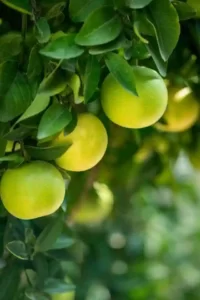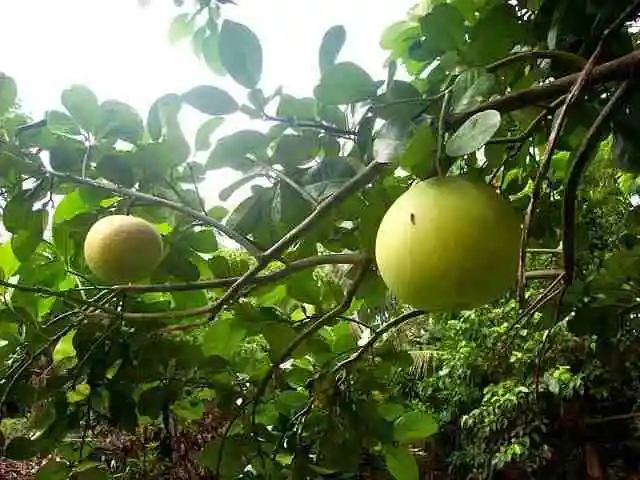Pomelo Farming | Pomelo Cultivation | 89Lac Per acre
Introduction of Pomelo Fruit: –
Pomelo is a large Asian citrus fruit Just like a grapefruit in the world. Some Common names of Pomelo in India are Jabong, Pommelo Shaddock, Pummelo, and Chinese grapefruit. The scientific name of Pomelo is Citrus maxima or Citrus grandis and these fruits are from South and Southeast Asia. It belongs to the genus “Rutaceae” and citrus. The thick and yellow-skinned fruit is known in the Western world as pomelo (pummelo, pomelo), shaddock, Batavia lemon, or pampelmos.
In India, this fruit is known as ‘Chakotra’. However, the name also technically suggests grapefruit, although both are different species under the citrus genus. This Delicious fruit is used as fresh and is also used for making Sweets, desserts, and jellies. The pomelo fruit has the taste of grapefruit without much bitterness.

Land preparation, spacing in pomelo cultivation: –
Prepare the land till fine threshing stage by 3 or 4 plowings and desi plowing. It also clears weeds from previous crops and levels the ground. The pits should be dug about 0.5 deep and wide. In pomelo farming, plant spacing should be maintained at 24ft to 30ft, and 18ft to 24ft which will accommodate approximately 130 to 240 plants per 1 hectare of land. Mix the bottom compost in the pits or one-third of the topsoil which will be used to refill the pits after planting. If raw manure is used, it is recommended to delay the planting by 2 weeks.
An adult pomelo tree grows to a maximum height of 55 feet. Due to its large size, your distance should reflect at least 11 feet so that there is enough space for the roots to spread. If you grow several pomelo trees in a group, the limbs will bend due to improper spacing. The canopies eventually come together in a large crown that is difficult to prune and the lower limbs get more shade and the fruit cannot grow in this shaded area. Placing a maximum distance of 16 feet between the trees ensures that each lemon tree has sufficient light and soil sources for optimal growth.
In sloping soils and stumbling plantations, the field can be prepared by cutting vegetation and clearing the immediate perimeter of the hills. Otherwise, the land should be thoroughly prepared by plowing. Pits or pits about 0.5 m deep and wide are then dug. Depending on the terrain and soil fertility, the distance from plant to plant is 24-30 ft x 18-24 ft. This is equivalent to a population density of about 130 to 240 trees per hectare.
Soil and Climate Requirements for Pomelo Cultivation: –
Pomelo fruit can Rise in a wide variety of soils from coarse sand to heavy clay. If the soil is acidic, it will be useful to apply lime to the soil. It will be better for the pomelo plants in the early rainy season Otherwise in Irrigated areas Planting can be done at any time during the year. Drip irrigation options will be selected for the best effective water management. Depending on the terrain and soil fertility, the distance from the plant to plant is 24-30 ft x 18-24 ft
Though, it grows well in low-lying, medium-textured, low-lying fertile soils and at altitudes not exceeding 400m. The best soil pH is 5.5 to 6.5 and an optimum temperature from 30°C to 35°C with an annual rainfall of 150 cm to 180 cm is required for its excellent growth and production.
Propagation and planting Method in Pomelo Plantation:
the greatest system of propagation is air layering In Southeast Asia. Pomelo can be propagated by seed or asexually by stem cutting, grafting, air layering, and budding.
To Make sure that the supply of nutrients, compost is poured at the bottom of the hole or mixed in about one-fourth of the topsoil which will be used to refill the hole after planting. Overall, if raw manure is used, planting is delayed by at least 15-20 days. It is the best time to plant when the rains begin But where there is an irrigation system available, it can be done anytime all year.

Irrigation system to pomelo Plant
It is Very Important to Regular Watering Especially before flowering and after harvest.
Daily water supply needs to maintain the growth of new shoots and the growth of flowers and fruits.
Water immediately after planting to ensure contact with soil and roots and to prevent wilting.
For early flowering, irrigation is delayed until the dry season shows signs of wilting. The dried plants are then irrigated.
In the Case of the Maure pomelo plant, may need 150-200 liters of water per day during the dry period.
Intercropping & Weed control in pomelo cultivation: –
In pomelo farming intercrops like banana and betel nut or any vegetable, crop can be grown during young plantation. Then any shade-loving intercrop will be beneficial. to get some extra income, Farmers should always use intercrops in the main crop.
The pomelo crop needs regular weeding to remove soil moisture and nutrient struggle. Covering the base of the plant can prevent weed growth by using the suggested weedicides.
Pruning in pomelo plantation:
You need to prune your pomelo so that it does not grow more than its planting area. In general, pruning should be done after harvest, especially in March or April. These cutting Steps allow the tree to adapt to its new shape during the warm spring and summer months. As a result, the normal harvesting period between November and February Production is a healthy fruit with almost all organs as light enters from the pruned canopy for optimal energy production.
Pruning should be done 6 to 7 months after planting for branching. 4 to 5 branches that are Equally distributed in different horizontal directions should be kept and allowed to grow. This should be done by pruning at a distance of about 35 to 50 cm from the ground.
Although you can provide ideal spacing, pomelo plants are vigorously productive while healthy. It is possible that the pomelo left for wild growth will shade the nearby lemon tree and compromise its fruit-bearing capacity.
Fertilizers requirement for Pomelo | Pomelo fertilizer requirements
for good production, organic fertilizers along with chemical fertilizers are also more important, need to understand pomelo fertilizer requirements
Proper fertilization is a standard cultural practice in fruit production, especially with floral inspiration. Fertilizers should be improved every year according to the age of the plant. It should be placed in a pit at a distance of 6 to 9 ft from the trunk.
Foliage fertilizer is also useful for each new flush. It should be given in 2 doses, the first dose before flowering and the second 5 to 6 months later.
In the Philippines, the recommended rate of 5-21 kg of organic and 4-14 inorganic fertilizers per plant per year increases with age.
Pomelo Cultivation Pests and Diseases
- In general, most of the pests and diseases that attack the citrus crop are also found in pomelo cultivation. there is under some Pests and diseases found in pomelo cultivation.
- Pumelo major disease is bacterial cancer caused by Xanthomonas citri.
- Both fruits and leaves are also infected by scabs caused by Elsino foci.
- Fruit bagging is a recent innovation to prevent serious damage caused by pests and diseases.
- All lemon pests also attack pomelo plants.
- Oily spots appear on leaves and fruits, which later turn brown and corky.
- Other diseases are root rot, gumosis on the stem, and brown rot of the fruit, all caused by Phytophthora fungus.
- Control methods include dissolving and burning severely infected plants, so as not to spread.
- For the control of fungal diseases, frequent spraying of chemical fungicides is recommended.
- Soot mold can be prevented by proper pest control
- These include common leafminers (Phylochnistis citrela), leaf-eating caterpillars, fruit-eating caterpillars (Citripestis sp), scales, red mites, and fruit flies, nematodes, and rats.
Get in touch with a local gardening branch for control processes.

Health Benefits of Pomelo Fruit: –
Some of the health benefits of pomelo fruit are as follows.
- It is easy to add Your diet
- Pomelo fruit helps prevent the common cold and flu.
- Pomelo fruit helps prevent anemia
- Pomelo fruit prevents UI (Urine Infection).
- Pomelo fruit promotes healthy teeth and gums.
- Pomelo fruit regulates blood pressure levels.
- Pomelo fruit helps in weight loss.
- Pomelo fruit helps to heal wounds.
Harvesting & Production in Pomelo Plantation
Generally, pomelo fruits are ready for harvest in 6 months to 7 months from the fruit set. Pomelo is harvested when it is freshly ripe. By sorting fresh pomelo, they are sold to traders or processing companies for domestic and export purposes. This change starts from the tip of the fruit and goes to the stalk.
Fruits should be controlled according to the age of the plant. For example, more than 50 fruits can grow on young trees. Normally, the Production of any crop depends on the variety, cultivation methods & climatic conditions. An average of 85 to 110 fruits can be obtained per tree/year or 18 tons/acre per year.
Pomelo farming profit per acre
Fresh Pomelo at Rs 550/KG to 600/KG
IF you calculate the gross profit for pomelo farming in 1 acre of land
Production of pomelo per acre we can assume it 18ton per acre, 1 ton its means 907 KG so 18ton means 16329 KG
Total production per acre is 16329 KG
pomelo price per kilo = 550KG
Total Gross profit for entire PRoduction of pomelo 18ton( 16329KG)
16329 KG * Rs.550 = Rs. 89,80,950 (Gross Profit)
You Can read this too